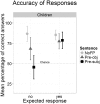Children's Comprehension of Sentences with Focus Particles and the Role of Cognitive Control: An Eye Tracking Study with German-Learning 4-Year-Olds
- PMID: 26930286
- PMCID: PMC4773164
- DOI: 10.1371/journal.pone.0149870
Children's Comprehension of Sentences with Focus Particles and the Role of Cognitive Control: An Eye Tracking Study with German-Learning 4-Year-Olds
Abstract
Children's interpretations of sentences containing focus particles do not seem adult-like until school age. This study investigates how German 4-year-old children comprehend sentences with the focus particle 'nur' (only) by using different tasks and controlling for the impact of general cognitive abilities on performance measures. Two sentence types with 'only' in either pre-subject or pre-object position were presented. Eye gaze data and verbal responses were collected via the visual world paradigm combined with a sentence-picture verification task. While the eye tracking data revealed an adult-like pattern of focus particle processing, the sentence-picture verification replicated previous findings of poor comprehension, especially for 'only' in pre-subject position. A second study focused on the impact of general cognitive abilities on the outcomes of the verification task. Working memory was related to children's performance in both sentence types whereas inhibitory control was selectively related to the number of errors for sentences with 'only' in pre-subject position. These results suggest that children at the age of 4 years have the linguistic competence to correctly interpret sentences with focus particles, which--depending on specific task demands--may be masked by immature general cognitive abilities.
Conflict of interest statement
Figures








References
-
- Jackendoff R. Semantic Interpretation in Generative Grammar. Cambridge, MA: MIT Press; 1972.
-
- Reinhart T. The processing cost of reference set computation: Acquisition of stress shift and focus. Language Acquisition. 2004;12(2):109–55. 10.1207/s15327817la1202_1 - DOI
-
- Rooth M. A theory of focus interpretation. Natural Language Semantics. 1992;1(1):75–116. 10.1007/BF02342617 - DOI
-
- Rooth M. Association with Focus. Amherst, MA: University of Massachusetts, Amherst; 1985.
-
- Costa J, Szendrői K. Acquisition of focus marking in European Portuguese: Evidence for a unified approach to focus In: Torrens V, Escobar L, editors. The Acquisition of Syntax in Romance Languages. Amsterdam: John Benjamins; 2006. p. 319–29.
Publication types
MeSH terms
LinkOut - more resources
Full Text Sources
Other Literature Sources

